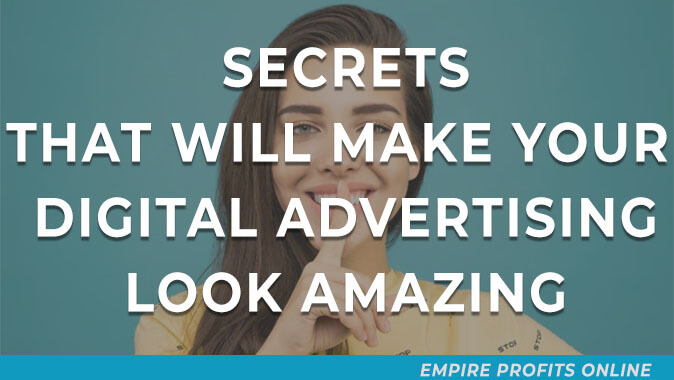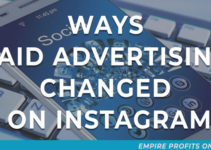Digital advertising is more complex than it seems at first glance. If you want your ads to look amazing, you will need more than a good graphic designer to pull it off!
In this article, I share with you 7 big secrets that will make your digital advertising look amazing.
Digital advertising has made its way into every corner of our daily lives. The reason is really simple: Who doesn't use the Internet nowadays?
The truth is that digital marketing takes advantage of this influx of users. In addition, it analyzes behavior patterns and the performance of the strategies implemented.
So that the content provided to the user can be more effective through the Internet.
Currently, there are many different ways to implement digital advertising. However, one that catches everyone's attention is the one focused on inbound marketing. This modality focuses on indirect and friendly advertising.
For this reason, below I will share with you some of the biggest (known) secrets of digital advertising that, even when not directly related to design, will make your advertisements look better.
1. Digital advertising pretends not to look like advertising
It may seem contradictory, but this is one of the greatest secrets of digital advertising.
Marketing techniques were advancing to be fully installed on the network. Thus, marketers realized that interaction with users was a great opportunity.
So they began to devise new techniques that prevent their content from looking like advertising.
How?
Looking for a link with the customer, without forcing him to consume anything. At least not in an invasive way.
Avoid being invasive
In traditional advertising, it was very common for people to feel overwhelmed by advertising.
This was mainly due to the techniques that were used to reach the audience. In fact, this is not exempt from digital advertising.
Since, in the beginning, the clear idea was to implement the ads as it was done in magazines.
However, as mentioned above, the key to digital advertising today is to be as non-invasive as possible. But how to achieve this?
Content is the key to everything!
Precisely: content is the key. If the usual advertising is intended to move emotions. In digital advertising, the aim is to engage with the user.
Understand their interests and provide useful, eye-catching, and reliable information. In addition to generating friendly interactions that allow brands to take advantage of the benefits of the virtual.
In this way, content marketing in digital advertising is the key.
2. Cater to your users
In this type of advertising, the connection with users is extremely important. We cannot lose sight of the fact that they will be the potential customers.
Thus, it's necessary to generate trusting interactions. In such a way that useful and accurate links can be developed.
The Internet is practically “omnipresent”. By this, we mean that at no time can we ensure that the user we want is at the right time and place to see and pay attention to the ad we have created.
Therefore, it is essential to take into account and study very carefully three variables when creating an advertisement that will reduce our % of mistakes.
- The target, defining the characteristics of the user we want to impact. For example, demographic data, lifestyle, interests, social profile, purchasing level, device with which he/she navigates…
- Location. You must be clear about where your user is located and target your advertising only to those places.
- Context: What is your audience doing, are they at home, using an APP, browsing with their mobile, playing a game, watching videos…?
Implement strategies to filter your brand's destination
Virtual tools allow us to mark the destination to which we can guide our brand.
The Internet, over time, has developed algorithms that allow it to be more intuitive with users. Digital advertising makes use of these algorithms.
The aim is to be as specific as possible with the themes that are developed. So that the search engine algorithm sends brand information to possibly interested users.
So now you know: the ads that appear in your navigation are not random.
3. Advertise something useful and relevant to your audience
If there is no good product, service, or company behind it, there will be nothing to do. The best ad will no longer be the best ad.
Clicking on the ad should not be the main objective if there is not something useful and relevant to show that will keep the user longer on the page so that, finally, they end up hiring your services or buying your products.
Aim towards conversion
To do this, you must be very clear about what your objectives are, what you want to achieve before carrying out any advertising campaign: are you looking for them to fill out a contact form, download a PDF, sign up for a newsletter, make a sale, or simply get to know your brand?
Once you are clear about this, you can target ads more effectively. For example, let's say we have an online store and a user abandons a cart without buying.
Our main objective is the purchase.
Therefore, we could carry out a remarketing campaign that would impact only those users who have already been interested in carrying out the conversion we want but have not completed the process. Don't you think it is interesting?
4. Create attractive, realistic, and explanatory ads
Whether you are looking to create an impact or to get a click, your ads must attract the user's attention and stand out from the rest, arousing curiosity so that they finally end up entering your website or remembering your brand.
You are not the same as your competitors, so you must focus on highlighting your differential values that, in turn, fit with the expectations that are created in the user once the ad is viewed.
Create ads that are different, unique but at the same time realistic and objective.
Do not promise something in an ad that will not be fulfilled.
For example, if most of your competitors write in the ad “Online Perfume Shop”, use a different claim such as “Perfumes at 50% Discount”, “Last Offer in Perfumes”, etc.
Use landing pages that are relevant to what you are advertising
As we have already mentioned above, not only should we not misrepresent our calls to action, but we should also show in the ad the living portrait of what the user will find on the web if he clicks on the ad.
For example, if the landing page is for dog food, the ad should NOT say animal food, but dog food.
5. Adapt your ads to any device
Most advertising platforms already take care of adapting the ads automatically depending on the device where they are displayed.
But when you create an ad, especially if it is a banner or video, you should consider the different sizes in which it will be displayed and make sure it is understood correctly. Check the texts and images.
This is especially important also in the case of promotional emails, which can be opened both from a computer with a 22″ screen and from a small smartphone.
If you are not prepared for this, it is better not to advertise on certain devices than to create a bad experience.
Are you familiar with the concept of responsive? Apply it not only to your website but also to your ads.
6. Test your ads
Once the designs have been created, it is highly recommended to test several variants of the ads. In this way, you will be able to analyze which of them has greater reach, impact or performance, and generates a greater benefit.
This is especially important when working with social platforms since the “freshness” and how recent an ad is taken into account when distributing it.
Users quickly get tired of seeing the same ad. Therefore, you should think about renewing them continuously, but testing what kind of messages and calls to action work best.
Test with designs, titles, texts, buttons, and calls to action. In this way, your ads can be updated with small modifications, without the need to invest a lot of resources.
7. Whatever your objective, measure everything you can and check the results
We could say that this is one of the most important tips when creating an ad on any online platform.
It will be absolutely useless to advertise if we are not able or interested to measure the real results we get thanks to the advertising campaigns we are carrying out.
It is often believed that digital advertising acts just for the sake of it.
But, the reality is that it follows the patterns of data collected: Which post have more people interacted with? Which content has generated sales? How many new leads? All this information, added to the comments on the product, allows a better analysis of the results of your brand.
The advertising platforms provide us with small scripts or pieces of code that are inserted into the web and allow us to measure the results of the campaigns.
For example, the AdWords conversion code or the Facebook conversion pixel. There are also techniques and tools to measure more complex aspects such as call conversions.
In addition, if you want to have a much more objective monitoring, we recommend free tools such as Google Analytics to measure traffic, goals, and transactions or Hotjar to generate heat maps and clicks.
What did you think of these 7 tips to make your digital advertising look amazing?







